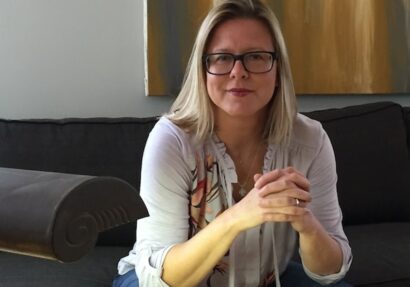Dr. Catherine Futter is the Director of Curatorial Affairs at Nelson-Atkins Museum of Art in Kansas City. Starting her career as a decorative arts curator, she now focuses on contemporary art, and projects that explore how visitors participate with works of art. Catherine provides listeners with an in-depth look at the ways artists and curators execute an exhibition, and what it’s like to work with a museum curator. Listen to the episode and leave a review to let us know what you think.
Initiating the exhibition:
- “Something sparks your interest, you find an artist who touches a nerve. There’s something about the work that you want to show to the public, that will open the visitor’s eyes and make them see the world in different ways.”
- “It’s about having the conversation: ‘are you still following this path, is there something you’ve always wanted to try?’—it’s those conversations that lead us to the exhibition.”
- “There’s that excitement of seeing work you’ve never seen before, and working with an artist who is pushing their work in new directions with something they’ve always wanted to try.”
Taking care with relationships:
- “I think our entire field is about personal relationships. A collector, intellectually, gives a piece to a museum, and yet they give it because of the relationship with the director, the curator, or the conservator.”
- “That’s what I would miss if I stopped curating—working with living artists, and those conversations that open my mind about what art can be, what our lives can be, and how our lives can be transformed.”
- “If there’s an artist with work that doesn’t quite fit with the museum, we can still tell collectors, ‘This is somebody I think we should all be watching.’ And that can take you different places—relationships are so important.”
The curator-artist exchange:
- “I met with Claire Twomey on a project, we sat at her table playing with plastic cups and paper, had a fantastic conversation and it moved the project forward.”
- “The most disappointing studio visit was when I had been so excited by this one artist’s work, but the artist responded with: ‘just tell me the schedule, the budget, and the space.’ That’s not the way I like to work.”
- “I consider these projects that I’ve worked on an experimentation, in that we’re all working together to move an artist forward in the projects they want to do.“
Career-planning:
- “Project-oriented artists can be torn between if they should be in the marketplace with work that’s collectible, or whether the interaction with community is vital to their work. There’s that balance between wanting to do your work, and being able to survive while doing your work.“
- “As a mentee, it has certainly furthered my career as I got insights into strategical thinking and strategic planning: if you want to get from point A to point D, what is your path going to be? Maybe it’s not a straight line.”
- “It’s not about sending curators slides or images of your work—that rarely goes anywhere. It’s exposure. Or it’s other curators saying ‘Hey, I met this person, maybe you’d like to work with them.’ We talk to each other all the time. Getting your work where it can be seen is very important.”
Where the museums and the art market meet:
- “They’re not separate at all—the market and museum—there are galleries now where there’s very little work in the exhibition that’s for sale. They’re publishing books and ‘competing’ with museums. The lines are becoming blurrier and some of that is positive.“
- “The art world has always been about commerce. We’re not an island by any means, we have to be alert to the changes of the art market.”
- “We think about how the collection will be valued—not necessarily monetarily—50 years in the future, because we’re not in the business of buying and selling art. We are always thinking of the permanence of the collection.“






